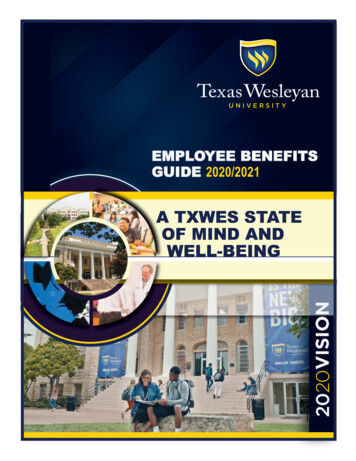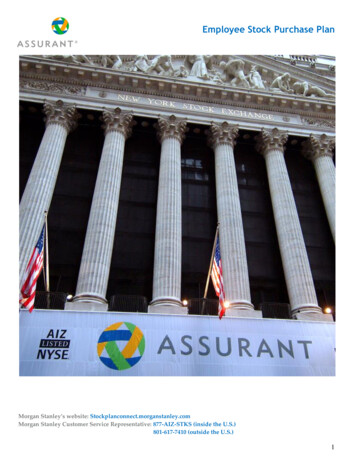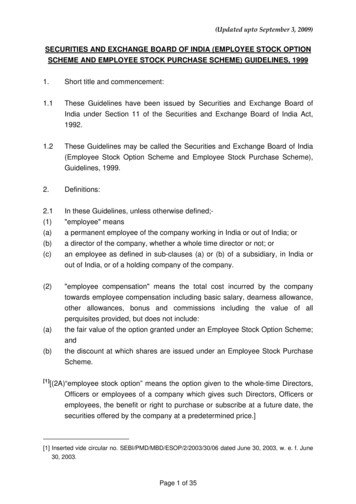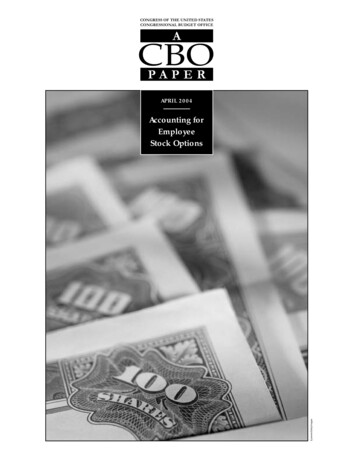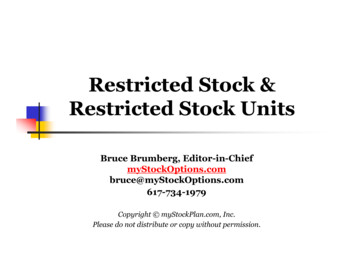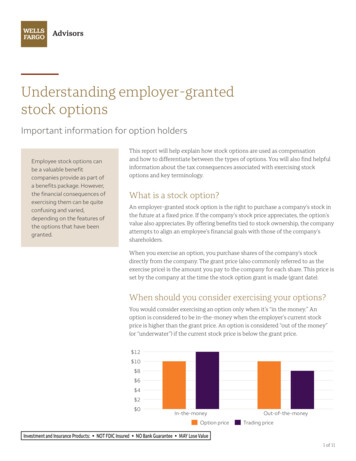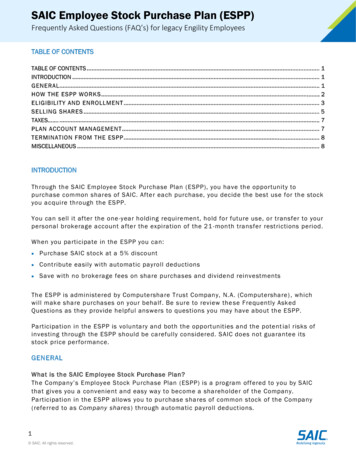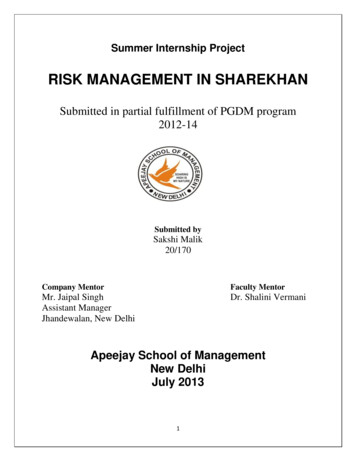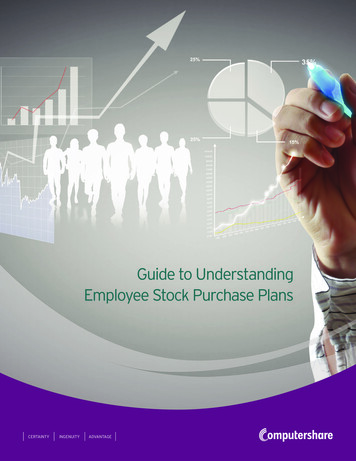
Transcription
Guide to UnderstandingEmployee Stock Purchase PlansCERTAINTYINGENUITYADVANTAGE
ContentsUnderstanding Your Employee Stock Purchase Plan 3The Advantages of Ownership. How Do Employee Stock Purchase Plans Work?. 33Participating in Your ESPP 4Eligibility .Offering Periods and Purchasing Periods .Enrolling in the ESPP or Changing Your Election .Contributing to Your ESPP .Withdrawing From Your ESPP .44444Managing Your ESPP Account 5Purchasing Shares .Your Purchased Shares . Dividends .Selling Your Shares .Limit Orders .Sale Restrictions .Receiving Net Proceeds, Stock or Stock Certificates .Receiving Your Net Proceeds .Accessing and Managing your Account .555555666Taxation of ESPPs 7W-8BEN/W-9 Certification .Qualified (423) Plans . Tax Consequences of Purchasing Shares Under the ESPP .Tax Consequences of Selling Shares Purchased Under the ESPP.What Is a Qualifying Disposition?. Tax Consequences of a Disqualifying Disposition .What Is a Disqualifying Disposition?. Tax Consequences of a Disqualifying Disposition .Incoming and Employment Tax Reporting and Withholding .Taxation on Dividends . 7777777777Glossary 102 Guide to Understanding Employee Stock Purchase Plans
Understanding Your EmployeeStock Purchase PlanEmployee stock purchase plans (ESPPs) are an important part ofa company’s total compensation package. ESPPs offer employeesthe opportunity to purchase company stock through regularlyscheduled payroll deductions. Your company is providing thisplan to promote a sense of ownership and to encourage a focuson the company’s long-term success. When purchasing stockwithin the ESPP, you become a stockholder with a personal stakein earning and sharing in your company’s success.The Advantages of OwnershipAn ESPP offers several advantages to an eligible employee:ConvenienceThe plan makes it easy to become a shareholder of yourcompany and share in any potential growth. There is always thepotential for growth but as with any investment there are alsorisks. There is no guarantee that the stock purchased throughthe plan will retain or increase in value.Your ESPP contributions will be made by automatic payrolldeductions on an after-tax basis. For more informationregarding the taxation of ESPPs, please refer to the Taxation ofESPPs section of this guide.Discounted PriceYour company may choose to purchase stock for you at adiscount — anywhere between 5% and 15% below the fairmarket value.No Purchase FeesYou will not pay any transaction or brokerage fees when sharesare purchased. Please note: brokerage fees may apply whenselling your shares at some point in the future.How do Employee Stock PurchasePlans Work?When you enroll in the ESPP, you decide what portion of yourpay you want to contribute to the plan. Your contributions arethen deducted from your pay on an after-tax basis and directedto a separate, non-interest-bearing account. At the end of theoffering period, your accumulated contributions are used topurchase shares of stock. Your shares are then credited to anaccount in your name at Computershare. Once the shares arecredited to your account, you can hold the stock and share in anyfuture growth, or you may sell the shares.FlexibilityYou can increase or decrease your contribution percentageor dollar amount, or withdraw from the plan, during eachoffering period. You can sell your shares, hold your shares withComputershare (the plan administrator) or transfer your sharesto a brokerage account. 3
Participating in Your ESPPEligibilityContributing to your ESPPYour company may have established guidelines that will help youdetermine if you are eligible to participate in the ESPP. Pleasebe sure to refer to your specific plan documents to review anyeligibility requirements.Your plan materials will indicate how much of your eligiblecompensation you may contribute to the ESPP. Yourcontributions are deducted from your pay and set aside in aseparate corporate account until the purchase date. On thepurchase date, your contributions will be used to purchasecompany stock. Please note that US tax laws for qualified plansmandate certain purchase limits, which apply to all participants.Should you reach this limit, you will be notified and yourdeductions will automatically cease and any deductions made inexcess of the limit will be refunded.Offering Periods and Purchase PeriodsThe offering period is a predetermined period during whichshares of your company stock may be purchased under theplan. The purchase period is the date upon which shares ofstock will be purchased on your behalf, using the contributionsaccumulated during the period.Enrolling in the ESPP or ChangingYour ElectionIf you are eligible to join the ESPP, you may enroll duringspecified enrollment periods established by your company. Whenenrolling, you will elect the amount of your contribution, in eithera dollar amount or a percentage of your pay. Your contributionswill begin as soon as administratively feasible. During a perioddefined by your company, you may elect to increase or decreaseyour contribution amount, or withdraw from the plan.4 Guide to Understanding Employee Stock Purchase PlansWithdrawing from your ESPPYou may choose to withdraw your participation from the ESPP.Please check with your plan’s documents to determine when youcan withdraw and what will happen with any contributions thatmay have accumulated.
Managing Your ESPP AccountPurchasing SharesSelling Your SharesYour contributions to the plan are deducted from your paycheck,placed into your account and used to purchase shares of stock.Contributions continue to be deducted until you withdraw yourparticipation from the plan or until your employment terminates.Upon the completion of your purchase, you will receive periodicstatements from Computershare, the plan administrator. Thestatement will reflect the number of shares purchased withyour payroll deductions, as well as other important informationregarding your account activity.You can sell shares through the Computershare website,www.computershare.com/employee/us, the Interactive VoiceResponse system (IVR) by calling the toll free number for yourplan or a Customer Service Representative. Check your planmaterials to determine if your company has established aholding period that must be satisfied before shares are sold. Youmay choose to sell all your shares or a portion of your shares.Every purchase made has a cost basis equal to the purchaseprice that is used in determining your capital gain (or loss)resulting from the sale. If you sell a portion of your shares, yourshares will be sold on a First-In-First-Out (FIFO) basis unless youspecify which share lot you wish to sell. A FIFO sale will sell theshares acquired from your first ESPP purchase.Your Purchased SharesOnce shares are purchased through the ESPP, Computersharewill allocate the shares to your personal account as soonas administratively feasible. Shares can be held as a longterm investment or you can choose to sell them at any time,unless your plan rules require you to hold the shares for aspecified time. If you choose to hold your purchased shares atComputershare, you will not be charged any administration feesfor maintaining your account.DividendsYour company may choose to share net profits with itsshareholders by offering a dividend. If you are a shareowneras a result of shares purchased through your ESPP, you will beentitled to any dividends paid. You may choose to receive thesedividends in cash or reinvest them in additional shares basedon your companies specific plan rules. Please consult your plandocument to understand what options are available to you.Because all company stock trades occur in real time, your saleprice is the market price of your company stock at the time ofthe sale. When you sell shares, you will receive an estimated saleprice. You can confirm the actual sale price by logging in to youraccount at www.computershare.com/employee/us.Please note: If you place a sell order after 3:45 p.m. EasternTime on NYSE trading days, your shares will be sold on the nexttrading day.Tax implications vary depending on how long the shares are held.You are responsible for all taxes, trading commissions and otherfees that may apply when selling your shares.
Limit OrdersLimit orders allow you to stipulate a specific price at which youwant your shares to be sold. If the stock price reaches or exceedsyour specified price after you place your order, your trade will beexecuted. When placing a limit order, it is important to know thatyour order will not be executed if the stock does not reach yourspecified price. With a limit order, execution is not guaranteedand may be executed in whole or in part. If the order is placed asa good-till-canceled order, unsold shares will remain as an openorder until executed.Sale RestrictionsCertain individuals may be subject to restrictions on sellingtheir shares during specified times of the year. Shares of stockpurchased through the ESPP are governed by your company’sinsider trading policy and federal securities laws. See the ESPPprospectus for more information.Receiving Net Proceeds, Stock orStock CertificatesReceiving Your Net ProceedsYour net proceeds are distributed via the method thatyou selected at the time of sale. You may choose from thefollowing options:USD CheckThe default method to receive proceeds is by a check. Checks inUS dollars are delivered by the US Postal Service at no additionalcost. Overnight deliveries are available for an additional fee.Non US Dollar ChecksNon US Dollar checks are subject to an additional fee.6 Guide to Understanding Employee Stock Purchase PlansDirect DepositYou can set up direct deposit instructions to transfercash proceeds online via Computershare’s website atwww.computershare.com/employee/us. Direct deposittransactions are subject to a fee.Wire TransferYou can set up wire instructions to transfer cashproceeds online, via Computershare’s website atwww.computershare.com/employee/us. Wire transfers aresubject to a fee. Over 100 foreign currencies are available fornon-US dollar wire transfers.Accessing and Managing your AccountLog in to your account at www.computershare.com/employee/usto view, manage and transact on your account. You can alsocall the Computershare communications center at the numberlisted on your plan correspondence. The Computersharecommunications center is available from 3:00 a.m. - 9:00p.m. ET. The same phone number may be used to access theComputershare Interactive Voice Response (IVR) system.
Taxation of ESPPsThe following briefly summarizes the US federal incomeand employment tax consequences associated with yourparticipation in the ESPP. It is applicable only to participantswho are residents or citizens of the US, including those workingabroad. Your state and local tax consequences, includingwhen amounts are subject to tax and your tax basis in sharespurchased, may vary from this description. This document isintended as a guide. Because the summary is general in natureand does not include information about state and local taxes, youshould consult with a personal tax advisor regarding your owntax situation.W-8BEN/W-9 CertificationWhen you log on to your account for the first time, you shouldcertify your tax status. If you are a US taxpayer, you shouldcertify on Form W-9. Otherwise, you should certify on FormW-8BEN. Form W-9 does not expire. Form W-8BEN expires onDecember 31 three years after the year you certify. By certifying,you will avoid having the backup withholding rate applied to thegross proceeds of any sales, as well as a default withholding rateon dividend payments.Qualified (423) PlansYour ESPP is intended to qualify as an “employee stock purchaseplan” within the meaning of Section 423 of the Internal RevenueCode of 1986, as amended.Tax Consequences of Purchasing Sharesunder the ESPPWhen you initially enroll or when shares of stock are purchasedfor you in the ESPP, you will not recognize compensation incomeor capital gains or losses. Typically, compensation income andcapital gains or losses are recognized when you dispose of theshares you acquire under the ESPP.Tax Consequences of Selling SharesPurchased Under the ESPPYour tax consequences of the sale (or other disposition) ofshares you purchase under the ESPP will depend upon howlong your shares were held. Specifically, the period of time forwhich you have held your shares determines whether you havemade a qualifying or a disqualifying disposition of your shares.The proceeds from any sale of shares will be reported to you onForm 1099-B.What Is a Qualifying Disposition?If you hold your shares purchased in the ESPP for at least twoyears from offering (grant date) and at least one year afterpurchase date, you will have made a qualifying disposition ofthe shares.Example: You acquire 100 shares of stock in an offering periodthat started on June 1, 2010, and a purchase period that ends onMay 31, 2012. If you sold the shares on March 5, 2014, you havemade a qualifying disposition of the shares, because they wereheld for more than two years after the offering period start dateand at least one year after the last day of the purchase periodduring which you acquired the shares.Tax Consequences of a Qualifying DispositionWith a qualifying disposition, you will recognize income taxableas ordinary compensation in the year that you sell or otherwisedispose of the shares equal to the lesser of:(1) The excess of the fair market value of the shares on the dateof disposition over the purchase price of the shares; or(2) Thefair market value of the shares on the first day of the purchaseperiod during which you purchased the shares, multiplied by thediscount offered to participants.Note: Ordinary compensation can never be less than zero. Also,the amount of compensation income you recognize will be addedto the tax basis of your shares. Any additional gain recognized willgenerally be taxed as a capital gain, discussed below. 7
Example: You purchase shares of company stock under the ESPPfor a price of 33.25 per share in a purchase period ending onMay 31, 2011. The fair market values of the stock on the first andlast day of the purchase period were 30 and 35 per share,respectively. You sell the shares in a qualifying disposition onMarch 5, 2014, more than 21 months from the purchase date, for 42 per share.Because 5 percent of the value of the shares on the first dayof the purchase period ( 30 x 5 percent 1.50) is less thanthe difference between the fair market value of the shares onthe sale date and the purchase price ( 42 – 33.25 8.75 pershare), you would recognize 1.50 per share as compensationincome. To determine your tax basis in shares sold, you add thecompensation income you recognize to the amount that youpaid for the shares, plus any fees paid ( 33.25 1.50 34.75per share). To determine the capital gain or loss on the sale, youthen compare your tax basis in the shares to the sale price. Inthis example, your capital gain is 7.25 per share ( 42 sale price – 34.75 tax basis 7.25 per share).If the fair market value of the shares on the date you sell theshares is less than the purchase price, no compensation incomeis recognized and the loss recognized will be a capital loss.What Is a Disqualifying Disposition?If, within two years of the offering period and within one yearafter the last day of the purchase period during which youpurchased the shares, you sell or otherwise dispose of the sharesof company stock that you purchased under the ESPP, you willhave made a disqualifying disposition of the shares.Example: You acquire 100 shares of company stock in a purchaseperiod that ends on May 31, 2013. If you sell the shares on June10, 2014, you have made a disqualifying disposition of the sharesbecause you did not hold the shares for more than 12 monthsafter the last day of the purchase period.8 Guide to Understanding Employee Stock Purchase PlansTax Consequences of a Disqualifying Disposition.If you make a disqualifying disposition, you will recognize incometaxable as ordinary compensation in the year that you sell orotherwise dispose of the shares equal to the amount by whichthe fair market value of the stock on the last day of the purchaseperiod during which you purchased the shares exceeded thepurchase price you paid. The amount of compensation incomeyou recognize will be added to the tax basis of your shares,and any additional gain recognized will generally be taxed asa capital gain, discussed below. You will recognize the ordinarycompensation calculated above even if your sale price is lessthan your purchase price.Example: You purchase shares of company stock under the ESPPfor a price of 33.25 per share in a purchase period ending onMay 31, 2013. The fair market value of stock on the last day ofthe purchase period was 35 per share. You sell the shares in adisqualifying disposition on June 10, 2014, within 21 months ofthe purchase date, for 42 per share. The compensation incomeyou recognize is equal to the amount by which the fair marketvalue of the company stock on the last day of the purchaseperiod exceeded the purchase price ( 35 – 33.25 1.75 pershare). The compensation income will be reported in federaltaxable wages shown on Form W-2. To determine your tax basisin shares sold, you add the compensation income you recognizeto the amount that you paid for the shares ( 33.25 1.75 35per share). To determine the capital gain or loss on the sale, youthen compare your tax basis in the shares to the sale price. Inthis example, your capital gain is 7 per share ( 42 sale price – 35 tax basis 7 per share).
Income and Employment Tax Reporting andWithholdingFederal Income Tax Reporting — Upon a disposition of shares,the income recognized as ordinary compensation will bereportable as federal wages on your Form W-2. However, underthe current guidance from the Internal Revenue Service, thisincome is not subject to federal income tax withholding.Federal Employment Tax Withholding — Under the currentguidance from the Internal Revenue Service, any income fromthe purchase of shares under the ESPP will not be subjectto Social Security and Medicare tax. Any changes in the IRS’position on this issue will be implemented as of the effective dateof that change.Taxation on DividendsDividends paid on shares purchased under the ESPP are treatedas dividend income received by the participant and are taxablein the year in which such dividends are paid. You will recognizethis dividend income even if the dividends are not paid in cashbut instead are reinvested in additional shares. Dividends will bereported to you on Form 1099-DIV. 9
Glossary1099 – An annual tax statement that is sent by a payer ofdividends, interest or sales proceeds to taxpayers. This statementis forwarded to the IRS and to the individual taxpayer.Common Stock – A security that represents units of ownershipof a public company. An owner of common stock would typicallybe entitled to proxy votes and any dividend payments made bythe company.Dividend – A distribution to shareholders that represents a sharein the company’s profits. Dividends may be paid in either stock orcash.Enrollment Period – Typically, the first day of the offering periodin an ESPP. Also referred to as the grant date.Fair Market Value – The price for which a company’s stock canbe bought or sold at a given time.Offering Period – See Enrollment Period.Market Price – The price at which a stock is sold.Proceeds – The total amount you receive from the sale of yourshares, less any costs or fees.Purchase Date – The date on which an exercise of a stock optionis effective. With ESPPs, the purchase date is the last day of theoffering (or purchase) period, when shares of your company’scommon stock are purchased with your accumulated post-taxpayroll contributions.10 Guide to Understanding Employee Stock Purchase PlansPurchase Period – An interim period within an ESPP offeringperiod, generally when the offering period is longer thansix months (e.g., 12 months or 24 months). With a lookbackprovision, the purchase price at the end of a purchase periodis usually based on the fair market value on the first day of theoffering period (or on the date you enrolled, if later) or on thelast day of the particular purchase period (whichever is lower).Purchase Price – The price paid to purchase shares. If a discountis offered, the purchase price will be the fair market pricemultiplied by the discount percentage.W-8BEN – Certificate of Foreign Status form required by the IRSto tell the payer, transfer agent, broker or other middleman thatan employee is a nonresident alien or foreign entity that is notsubject to US tax reporting or backup withholding rules.W-9 – A form that is required by the IRS for US taxpayers andcitizens to certify their Social Security number or TaxpayerIdentification Number. If form W-9 is not completed, sales ofstock may be subject to backup withholding tax.
11
Computershare is a global market leader in transferagency, employee equity plans, proxy solicitation,stakeholder communications, and other diversifiedfinancial and governance services. Many of theworld’s leading organizations use Computershare’sservices to help maximize the value of relationshipswith their investors, employees, creditors, membersand customers.www.computershare.comThis guide is intended for informational purposes only. Computershare does not provide financial planning or tax advice. Please speak to your financial advisoror your tax advisor to discuss your individual situation. 2014 Computershare Inc. All rights reserved Participant Guide ESPP Qualified 073014
Participating in Your ESPP coNTribUTiNG To YoUr ESPP Your plan materials will indicate how much of your eligible compensation you may contribute to the ESPP Your contributions are deducted from your pay and set aside in a separate corporate account until the purchase date On the purchase date, your contributions will be used to purchase




